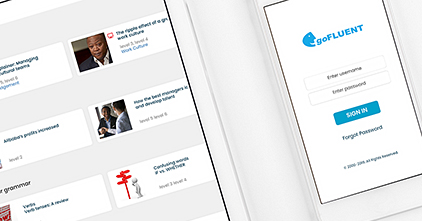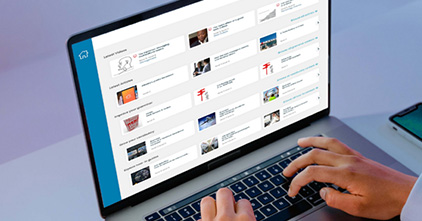- What Digital Transformation Looks Like in Education
- Examining Challenges in Language Education and Possible Solutions
- Challenge #1: Adapting Language Teaching to a Diverse Student Body
- The Solution: Introducing Multilingual Courses
- Challenge #2: Catering to Preferences of Digital-native Students
- The Solution: Embracing Multi-Device and Multimedia Learning
- Challenge #3: Integrating Digital Tools and Addressing Artificial Intelligence (AI)
- The Solution: Streamlining Tech Adoption
- Challenge #4: Ensuring Students Develop Modern Workplace Skills
- The Solution: Teaching Transferable Skills
- Embracing the Future of Language Education
Digitalizing language education in a school setting can take time and effort. Discover how to overcome key challenges and how an education partner like goFLUENT can help universities and vocational schools transform their language education programs.

In today’s tech-driven world, every aspect of our lives— from how we work, shop, socialize, and consume entertainment—is getting a digital makeover. This doesn’t stop in our day-to-day life. Education is at the forefront of this change as well. Technology is playing a central role in upgrading teaching methods and learner experiences.
Yet, amid the excitement of this digital revolution, educators grapple with unique hurdles. This article looks at those challenges and outlines innovative solutions to overcome them.
What Digital Transformation Looks Like in Education
At the forefront of learning innovation, some universities in the United States (U.S.) are dedicating labs to develop and test new ideas. These include computer simulations, virtual teaching assistants, automated grading, and personalized teaching platforms.
Technical and vocational training schools are using technology to make learning more interactive. They are setting up internet connections, adopting learning management systems, and using video conferencing tools.
For foreign language education, digitalization is about using mobile devices, computers, and online resources to deliver learning content.

Examining Challenges in Language Education and Possible Solutions
Alongside advancements come unique issues that educators need to address. Below are effective strategies to help schools navigate them.
Challenge #1: Adapting Language Teaching to a Diverse Student Body
Schools today have diverse student populations. While this is an opportunity to expose students to a multicultural environment, it is a challenge for teachers to adjust their methods. Additionally, many schools lack multilingual programs. This makes it difficult to organize classes for a multilingual student body.
Even though English is the main language used in higher education, research shows that non-native speakers struggle with this approach. Many students report feelings of inferiority, lack of motivation, and low self-esteem. This highlights the need for targeted support to make sure all students succeed in a multicultural environment.
The Solution: Introducing Multilingual Courses
Embracing multilingual education is essential to meet the needs of diverse students. Offering various language courses helps students bridge the gap between their current skill level and the curriculum’s expectations. goFLUENT’s Organization-wide License offers courses in 14 languages. Teachers will have all the materials they need to tailor learning plans so students can catch up. And by embracing multilingual education, schools raise their educational standards. They also reduce the expenses associated with running onsite language programs.
Challenge #2: Catering to Preferences of Digital-native Students
Smartphones, tablets, and laptops are part of every student’s daily essentials. A survey from November 2021 found that 99% of college students use laptops. Eighty-one percent of them use smartphones. Additionally, students respond more to lessons that incorporate multimedia elements. Teachers can use this as an opportunity to make lessons more engaging.

The Solution: Embracing Multi-Device and Multimedia Learning
Modern language programs must accommodate students’ digital preferences. goFLUENT’s Language Academy contains a rich library of multimedia resources. These include videos, articles, and interactive exercises designed to engage students. The Language Academy can also be integrated into the school’s learning platform. It is accessible on many devices through the goFLUENT Mobile App.
Challenge #3: Integrating Digital Tools and Addressing Artificial Intelligence (AI)
As teachers juggle their teaching responsibilities alongside administrative tasks, using digital tools offers a promising solution. However, educators unfamiliar with these tools struggle with them.
Moreover, teachers have mixed feelings about using AI in education. A 2023 U.S. survey revealed that 49% of teachers found that AI made their jobs harder. They struggle with verifying students’ work due to concerns about plagiarism. This is because students are dependent on generative AI to do their assignments. Yet, 63% of teachers recognized AI’s benefits. They view it as a useful tool for tracking students’ progress and providing personalized feedback.

The Solution: Streamlining Tech Adoption
goFLUENT offers a comprehensive solution through its Client Admin Center. It helps teachers streamline their administrative tasks and free up valuable time. Teachers can focus on giving students much-needed guidance.
Educators can also leverage students’ preference for AI by providing writing lessons powered by goFLUENT AI. This innovative tool provides immediate feedback on a student’s written output. It identifies strengths, pinpoints areas for improvement, and offers recommendations. It saves teachers time and effort in assessing students’ work. At the same time, students enjoy an engaging and personalized language learning experience.
Challenge #4: Ensuring Students Develop Modern Workplace Skills
Twenty-first-century learning challenges universities today to prepare their students for the modern world. This is regardless of the careers students choose to pursue. It’s about teaching learners core competencies valuable in any professional context.

The Solution: Teaching Transferable Skills
Modern language education is about the development of sought-after skills in the workplace. These include digital literacy, problem-solving, collaboration, and communication. goFLUENT offers courses specifically tailored to develop these. These include global and professional communication, as well as diversity and inclusion. Students can also learn job- and industry-specific skills, as well as language essentials.
Embracing the Future of Language Education
Integrating technology into higher education and vocational training enhances teaching and learning.
Let goFLUENT be your partner in navigating the challenges of 21st-century learning. goFLUENT combines technology, content, and human interaction to make learning meaningful and effective. Join us in revolutionizing language education for your institution today.



